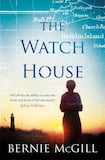
The characters of Bernie McGill's accomplished new novel The Watch House are glic, that old Irish word that belies exact translation. Sly, cunning, shrewd, clever – these adjectives come close but are not pinpoint. It's a word that seems particularly pertinent to the people of old Ireland who had to battle poverty, famine and foreign rule to stay alive.
The inhabitants of Rathlin island off the Antrim coast in the late 19th century are a glic bunch. Keeping your wits about you, knowing the landscape and the devious ways of fellow islanders are vital to survival, especially for women. The protagonist Nuala Byrne’s family emigrated to Newfoundland when she was a child. Left on the island to look after her grandparents, Nuala has wisdom beyond her years: “It’s an odd bittersweet thing to grow up with old people. The taller you get, the more bent and frail they become, like there’s only so much space or straightness to go around.”
Given the gift of healing from her grandfather, Nuala has an innate sense of the land and the power of nature that helps her earn a crust but is barely enough to sustain her. Realising that she needs security, Nuala accepts an offer of marriage from the island’s ageing tailor. It is a glic move that ultimately backfires when the tailor’s older sister Ginny becomes part of the package.
Spinster Ginny, “sharp as a blade of arrow grass”, takes glic to a new level. She is suspicious of everyone except her brother, and orders Nuala about like a skivvy as she installs herself in the kitchen “shooting dulse into the grate, the red juice running down the sheugh of her chin”. McGill has a wonderful capacity for original character description that harks to the era. Through Nuala’s eyes, the tailor himself is “slight, with skinny legs and a high hairline, and heavylidded eyes and a nose like a peregrine”. The malevolent Tam Casey, who personifies the darker side of glic, “is as soapy as a peeled parsnip”.
Complex and beguiling
This is McGill's second novel, following the Northern Irish writer's acclaimed debut The Butterfly Cabinet and a short-story collection, Sleepwalkers, that was shortlisted for the Edge Hill Short Story Prize. Her assured style and eye for detail makes The Watch House a pleasure to read, a fast-paced tale that rarely flags, with a complex and beguiling heroine at the helm.
McGill’s research of the era comes through in character. Nuala brings readers on a tour of the island, from the dry caves at the lower end to “the warbly croaks of the black-headed razorbills”, to the time she had to herd the sheep back during a storm from a cliff top near Cartruan: “The sea in Altachuile Bay [was] darker still, the beam from the lighthouse to the east growing stronger by the second.”
The titular watch house comes into play when an Italian technician lands on the island to test out Marconi’s new Morse code technology. Money-hungry Ginny orders Nuala to apply for the role of cook, which later turns to scribe as her intuition for the technology is spotted by Gabriel. The Italian spots more than intuition in his dark-haired protege and a romance full of banter and suspense develops.
Central theme
Communication is the novel’s central theme, as Marconi’s radio boxes allow people “to shoot their words out over the Moyle like pellets out of a gun”. Old values clash with new means. Ginny notes that it’s not right to separate a person from their words, to put that much sea between the two. A body could say anything then and feel no responsibility for it”. Nuala initially believes that a word is something to feel in a throat until Gabriel convinces her otherwise, pointing out that “impossible is a term relative to time”. Communication proves the downfall of the pair as well, in a neat twist that shows how information is power and that power often corrupts.
Not everyone is out for blood on Rathlin, and the kindliness of characters such as Dougal and Dorothy recall the communities of the novels of Walter Macken. Recent historical fiction from authors such as Emma Donoghue and Nuala Ní Chonchúir also come to mind in the exacting detail, lively dialogue and plucky female narrators with a sharp sense of humour. “Haven’t you a cow?” The tailor’s proposal to Nuala is full of romance. “Many’s the one came with less.”
A narrative shift towards the end gives a compelling new perspective but also disrupts Nuala’s story. It is her voice that readers will connect with, trapped in a vice that is partially her own doing: “I’m in a gap in time, the lapse that happens between feeling the heat on the pot handle in your hand and knowing that you’ve been burned.” The watch house turns into a place of listening as well as seeing. It is a microcosm of the island itself, where the glic inhabitants are always tuned in.












